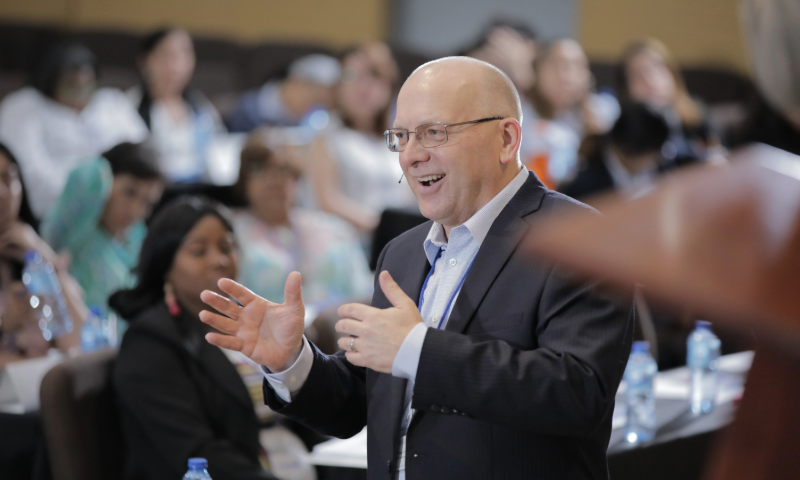Dr. Toby A. Travis is the creator of TrustED, a framework for school improvement focused on developing trusted leaders. In addition, he is an Executive Consultant with the Global School Consulting Group, an Adjunct Professor for the International Graduate Program of Educators for the State University of New York College at Buffalo, and an experienced teacher and school administrator, currently serving as the Head of School at Houghton Academy in Houghton, NY. As a guest speaker, trainer, and consultant, his work has taken him throughout the United States, Europe, South Asia, and Central and South America. Dr. Travis is the author of “TrustED: The Bridge to School Improvement.” This award-winning book for educational leaders reached #1 on Amazon’s Educational Leadership category book downloads in April 2023, has been featured in Forbes, CEOWorld Magazine, Authority Magazine, The Knowledge Review, eSchool News, on NPR, as well as numerous podcasts – and was named “Book of The Month” (November 2021) and nominated for “Book of The Year” (2021) by The Magic Pen.
In a recent interview with K12 Digest, Dr. Toby Travis discussed his experience with Executive Coaching, Leadership Development, and Educational Consulting. He shared his views on how executive coaching is developing and enhancing leadership skills, successful team building, managing organizational change, and many more.
What is the role of executive coaching in developing and enhancing leadership skills? How does it differ from other forms of professional development?
When school leaders engage the assistance of an executive coach/consultant, they benefit through the process in many ways: greater self-awareness, skill enhancement, personal and professional goal setting and action planning, feedback and reflection, insights to manage conflicts within the school, strategic decision-making, reduction of stress, professional accountability, and the list goes on.
Coaching is about personal application and contextualizing of best practices, whereas PD is training in best practices.
A crucial point for school leaders to consider when identifying an executive coach is to ensure the coach has experience at their level in school leadership. One of the important findings in leadership research is that the most skilled coaches are those who possess professional knowledge of the industry. Thus, the best coaches for school leaders are practitioners; in other words, they are school leaders themselves. They know and understand the nuances and unique challenges of leading a school.
How to assess the needs and goals of executives before designing a coaching program? What strategies do you employ to tailor coaching to their specific requirements?
Utilize a professional 360 assessment and let the data inform and guide the priorities of what the coaching needs to focus.
There are six major components to effective and successful school leadership (i.e., 1. Beliefs and Values, 2. Connection and Support, 3. Flexibility and Involvement, 4. Adapting and Contextualizing, 5. Culture and Relationships, 6. Clarity and Order), and all six need to be healthy and competent for school leaders to be trusted. Thus, clients must complete a 360 assessment that invites those whom they manage to provide insights into the client’s leadership strengths and areas for improvement. Based on the assessment of the six components of trusted leadership, we can then build an individualized and strategic plan for coaching, goal-setting, and action planning.

What are some common challenges that executives face, and how does coaching help them overcome those challenges?
The most common challenge is a breakdown between what a leader has expressed as their beliefs and values and how they live out those beliefs and values in their work. For example, if a school leader states that teachers are his or her highest priority but does not advocate teacher compensation, workloads, and classroom resources, then the leader will not be trusted.
How do you tailor leadership development programs to address the unique needs and strengths of individuals?
I utilize the data from the 360 assessment to identify the unique needs and strengths of the client.
How to incorporate coaching and mentoring into leadership development initiatives to foster continuous growth and learning?
Everyone needs a mentor. And every leader needs to be mentoring someone else. We often grow and develop the most ourselves by investing in others.
What are the foundational elements of successful team building? Can you share examples of team-building activities that have had a positive impact on team dynamics and performance?
Shared mission, vision, values, and priorities. Certainly, one example is a school leadership team that reviewed and affirmed its core values as an organization. Then, they reviewed their employee and student policy manuals to assess if existing policies and operational protocols did not align with their core values. They discovered that a number of the policies that had been developed over the years were a “knee-jerk” response to some infraction by an employee, student, or parent, but not necessarily in alignment with their stated core values. This prompted them to revise and update their operations’ elements, resulting in a more unified community and relationship between leaders, employees, students, and parents.

What are the key considerations in designing and delivering effective training programs? How do you ensure that training aligns with organizational objectives?
Training programs need to be authentic. In other words, they need to address real and current challenges. Additionally, the most effective training sessions are those where the participants do most of the talking. In education, we know that the one doing the talking is the one doing the learning. Effective training programs ensure participants reflect on the learning, talk about the learning, and identify and create actionable responses to the learning.
The school and organizational clients who reach out to me are almost always those who have already identified their need for increasing levels of trust in the leadership of the school or company. Thus, that objective has brought them to me, a specialist in helping schools and organizations develop, restore, if needed, maintain, protect, and ensure high levels of trust.
What are the critical factors in managing organizational change effectively? How to address resistance to change and foster employee buy-in?
Change, to be effective and lasting, must first and foremost be “owned” and led by the school’s leadership. Secondly, leaders of the desired change must demonstrate high levels of competency in whatever the improvement initiative involves. For example, if a school wants to move to standards-based grading and reporting, utilizing rubrics for all summative assessments, then the academic leaders of that school must be or become experts in standards-based grading, reporting, developing, and utilizing rubrics. To design and build a suspension bridge, the structural engineers must be experts in the nuts, bolts, and materials that go into building the bridge, even if they themselves are not the ones applying the wrenches.
As Simon Sinek says, “Start with the why.” When employees know and understand the need for and the benefit resulting from the change, they are far more likely to embrace the work required. Better yet, engage the employees in helping identify what changes are needed and the solutions. When they own the change, they are far more likely to embrace the work required to accomplish the improvement initiative.

How to measure the success of change management efforts? Can you provide examples of positive outcomes resulting from your change initiatives?
With my clients, we implement a 360 assessment, securing employee feedback approximately every six months. The data points from that feedback provide us with a statistical measurement of how the improvement efforts are progressing (or not).
Trusted leadership is the number one indicator of successful schools. And that success is seen in many areas. The schools that I have worked with, who have intentionally engaged in assessing their leadership, engaging in trusted leadership training, individual coaching, strategic goal-setting, and action planning, and then accountable to carry out and complete their plans have seen the following measurable outcomes: increased retention of quality employees, increased academic achievement levels of their students, increased volunteerism from the community, decreased operational costs, and decreased behavioral incidents of both students and employees.
How to approach data analysis and research in management consulting to provide evidence-based recommendations?
Schools and organizations must ensure they utilize professional and experienced consultants well-versed in evidence-based best practices. Yet, simultaneously recognizing that best practices must always be contextualized to the school or organization’s unique setting (e.g., population demographics, available physical and human resources).
What are the unique challenges and opportunities in non-profit organizations that require specialized consulting support?
For non-profit organizations, whose primary source of income is derived from the donations of individuals, the single most important asset they need to possess is the level of trust in their organization’s leadership and in its management of resources. Thus, it is imperative that non-profit organizations maintain continual assessments of their leader’s trust levels, as well as ongoing training, coaching, and monitoring to ensure a high level of trust is maintained. Harvard and the Rand Corporation have produced studies showing that when organizations invest in this type of ongoing professional development, the return on investment ranges from at least $1.85 to $7.00 on every dollar invested in securing the consultants, assessment tools, training, and coaching.




